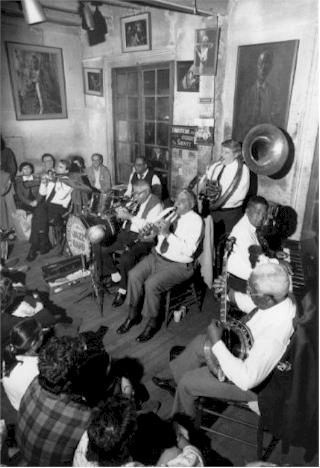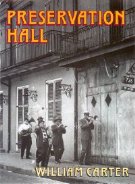
Percy Humphrey's Preservation Hall Jazz Band on a typical night, c. 1986. L - R: Frank Demond, trombone; Frank Parker, drums; Percy Humphrey, trumpet; Willie Humphrey, clarinet; Allan Jaffe, tuba; Sing Miller, piano and Narvin Kimball, banjo.
Preservation Hall has been operating continuously in the New Orleans French Quarter since 1961. On this edition of Riverwalk Jazz The Jim Cullum Jazz Band performs music made famous by the Preservation Hall Jazz Band.
Tunes on this broadcast include "Algiers Strut," "Over in the Gloryland," "Panama," "When I Grow too Old to Dream" and "Ice Cream."
Featured guest artist is the photographer, writer and clarinetist William Carter, author of the acclaimed book Preservation Hall—1991, W.W. Norton, US; and Bayou Press, Oxford, England. Mr. Carter and band clarinetist Evan Christopher perform a clarinet duet on "You Tell Me Your Dream."
A nostalgic collection of Mr. Carter's own thoughtful photographs and text as well as a treasure trove of historic photos from many sources, Preservation Hall evokes the spirit of traditional jazz in New Orleans' French Quarter. The following is excerpted from Preservation Hall with the author's permission:
"Under the weak overhead bulbs, the faces are like masks, with deeply shadowed eye sockets. The banjo man is strumming chords now, humming to himself, working on what sounds like a new composition. I have heard them, and so many others, the living and the dead, in so many other settings, at picnics and in Greyhound buses, and in concert halls from Midwestern colleges to New York's prestigious Lincoln Center. Throbbing heart of the operation, the Preservation Hall building is some two hundred years old, and, due to a policy of benign neglect, it looks it...
"And Willie Humphrey, my favorite living clarinet player, has just come in, wearing his huge Stetson hat and carrying his tiny instrument case all patched and wrapped with plastic tape...

SAMMY PENN, drummer with the Kid Thomas Band, shouting a number at Preservation Hall, probably late 1960's. His explosive style has influenced succeeding generations of drummers in the traditional jazz revival movement.
"The real secret of New Orleans music comes in the realization that a man no longer needs to run after it, or try to become it, because he already is it. Certainly there is learning to be done in some conventional musical ways. But the essence, formidable to many who lack African roots, is not so much in adding things, tensely filling up every space, forcing, mastering and intending; as in releasing, shedding stiffness, letting go the four-square order, celebrating the accidental and becoming one with the dance. The music creates the player, flowing not from him but through him...
"In other words, jazz is participatory—a dancing music, not a studying music. Instead of being stuck up on a pedestal to be worshiped from afar, the original jazz and its players have always been part of the fabric of life in New Orleans. Hence their down-to-earth ease and spontaneity...

SWEET EMMA BARRETT, pianist with her own and the Percy Humphrey bands, was one of the best loved and remembered Preservation Hall players both in New Orleans and on tour. She wore bells on her legs, dressed entirely in red, refused to travel by air, and carried her red purse onto the stage of major concert halls.
"From the earliest known times, constant enthusiasm and wide social polarities seem to have spanned the New Orleans music scene. Here, in contrast to the rest of the slavery-ridden South, relatively humane attitudes on racial matters intertwined with a passionate love of music, entertainment and dancing. The city was not a melting pot: among the earlier generations social and ethnic groupings remained quite distinct, and the mixing that did go on later among their descendants was not usually discussed. But cultural activities, such as Mardi Gras parades and music of many sorts, helped to mediate between the groups. This feeling for music as a meeting ground still prevails in the city...

ALFRED WILLIAMS, known locally as among the greatest of the New Orleans drummers, played regularly at Preservation Hall until his death in 1963. Here he plays in a street parade--a basic stylistic influence on early jazz and an essential proving ground for players of Louis Armstrong's generation.
"In jazz, as in literature, tone has much to do with the attitude of the artist to his audience and to himself. Take the trombone. Shouting, extroverted, gut-level players like Jim Robinson and Louis Nelson made their points clearly and without qualification. Reflection and conscious control intervened in the tone of more inward musicians like Preston Jackson or "Frog" Joseph, and in that of younger men who crafted their styles in the survey-course world of the "revival" period—such as Frank Demond and Freddy Lonzo...
"At concerts I can tell, by now, how each band member is feeling. Normally outgoing, clarinetist Willie Humphrey tonight spends most of the first half of a concert looking glumly down at his feet. Then, as the evening goes on, he gradually warms up. Spontaneously, a whole group in an upper balcony, with a lead soprano, joins in a churchy singing of "Closer Walk." The rest of the audience is caught between surprise, embarrassment, enjoyment and wondering how to react. Pianist-vocalist Sing Miller makes it okay by saying gently into the mike, "Yeah, SING that song." Later, a belly dancer in tight jeans does her thing off to one side of the stage. It all fits...
What will happen when that wonderful old generation of musicians is gone? Will their inner spirit be gone from the music too? Or will it have reseeded itself?"
Excerpts from Preservation Hall © 1991 by William Carter. Used with permission
Photo credit for home page teaser image: PERCY HUMPHREY'S PRESERVATION HALL JAZZ BAND on a typical night at Preservation Hall, c. 1986. See above for players.
Excerpts from Preservation Hall © 1991 by William Carter. Riverwalk Jazz script by Margaret Moos Pick ©2004


